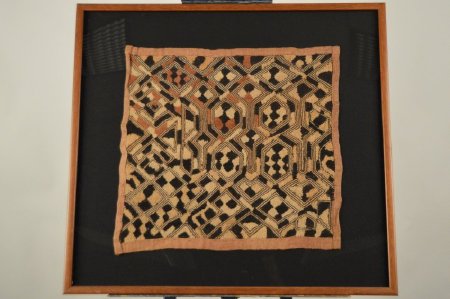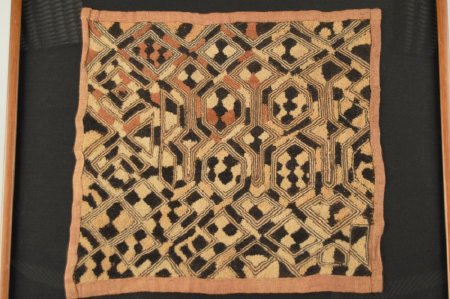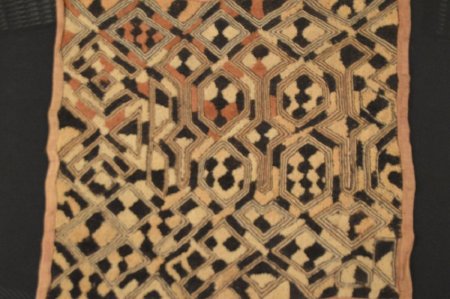Title:
Kuba, Raffia Cloth, Cut—pile, (Kasai Velvet or Shoowa Fabric)
Object Name:
Cloth, Raffia, Cut—pile, Panel
Other Name:
Cloth, Raffia, Textile, Shoowa Fabric
Place of Origin:
Kuba, Democratic Republic of Congo (Zaire), Africa
Provenance:
Aboriginal Indigenous Art.
L = 22" x 19"
W = 20 x 16—1/2"
The true jewels of textile art are the small Shoowa cut—pile cloths. Their compex interplay of geometric symbols, inventive rhythm and balance, uniquely individual designs and tight "velvet"surfaces created objects so mysteriously alluring the Kuba people traded them as currency and they were the standard by which a family's wealth and status were judged. These raffia cut—pile cloths, woven by men, were embroidered by women with no stitching visible on the back. Highly prized for their complex patterns, they are further embellished with tight tufting, leading to the nickname "Kasai velvet". They were sewn together for ceremonial dress and covered royal stools. As a sign of status and to provide for the afterlife they were buried with kings or those fortunate enough to own many
The thin dark lines are thought to be embroidered in the conventional manner. All the yellow parts of the design and the wider areas of black patterning are produced by the cut—pile technique.
Sometimes reffered to in the general sense as "Kasai Velvet". The thread that is used in the embroidery is a very fine raffia fibre which has been rubbed in the hands in order to soften it and provide the silky texture from which the comparison with velvet derives.
L = 22" x 19"
W = 20 x 16—1/2"
The true jewels of textile art are the small Shoowa cut—pile cloths. Their compex interplay of geometric symbols, inventive rhythm and balance, uniquely individual designs and tight "velvet"surfaces created objects so mysteriously alluring the Kuba people traded them as currency and they were the standard by which a family's wealth and status were judged. These raffia cut—pile cloths, woven by men, were embroidered by women with no stitching visible on the back. Highly prized for their complex patterns, they are further embellished with tight tufting, leading to the nickname "Kasai velvet". They were sewn together for ceremonial dress and covered royal stools. As a sign of status and to provide for the afterlife they were buried with kings or those fortunate enough to own many
The thin dark lines are thought to be embroidered in the conventional manner. All the yellow parts of the design and the wider areas of black patterning are produced by the cut—pile technique.
Sometimes reffered to in the general sense as "Kasai Velvet". The thread that is used in the embroidery is a very fine raffia fibre which has been rubbed in the hands in order to soften it and provide the silky texture from which the comparison with velvet derives.
Description:
Geometric buff, white and black stitchery on buff—colored cloth. Patterns used by female to set up ritually used cloth, almost like samplers.
Collection:
Finley Collection
Material:
Raffia Cloth
Used:
Ritually Used
Technique:
Weaving / Stitchery
Owned:
Art Department, MSSU
Accession#:
2014.1.140


